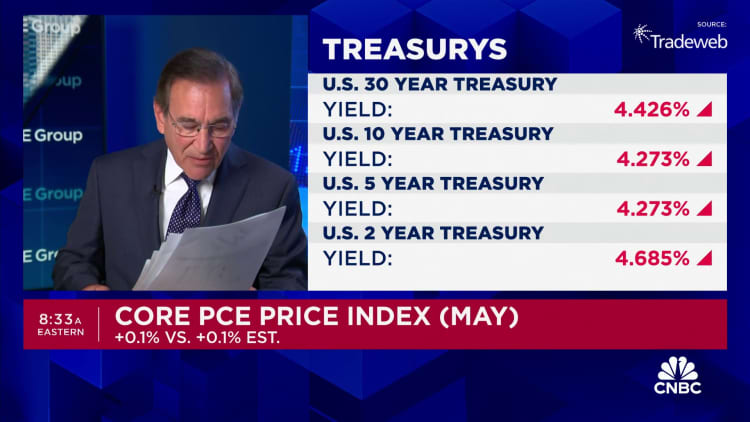
Key Fed measure shows inflation rose 2.6% in May from a year ago, as expected
CNBC
The core personal consumption expenditures price index increased just a seasonally adjusted 0.1% for the month and was up 2.6% from a year ago. May marked the lowest annual rate since March 2021, which was the first time in this economic cycle that inflation topped the Fed’s 2% target. Personal income rose 0.5% on the month, stronger than the 0.4% estimate. Consumer spending, however, increased 0.2%, weaker than the 0.3% forecast.
An important economic measure for the Federal Reserve showed Friday that inflation during May slowed to its lowest annual rate in more than three years.
The core personal consumption expenditures price index increased just a seasonally adjusted 0.1% for the month and was up 2.6% from a year ago, the latter number down 0.2 percentage point from the April level, according to a Commerce Department report.
Both numbers were in line with the Dow Jones estimates. May marked the lowest annual rate since March 2021, which was the first time in this economic cycle that inflation topped the Fed’s 2% target.
Including food and energy, headline inflation was flat on the month and also up 2.6% on an annual basis. Those readings also were in line with expectations.
“It is just additional news that monetary policy is working, inflation is gradually cooling,” San Francisco Fed President Mary Daly told CNBC’s Andrew Ross Sorkin during a “Squawk Box” interview. “That’s a relief for businesses and households who’ve been struggling with persistently high inflation. It’s good news for how policy is working.”
The Fed focuses on the PCE inflation reading as opposed to the more widely followed consumer price index from the Labor Department’s Bureau of Labor Statistics. PCE is a broader inflation measure and accounts for changes in consumer behavior, such as substituting their purchases when prices rise.
While the central bank officially follows headline PCE, officials generally stress the core reading as a better gauge of longer-term inflation trends.
Outside of the inflation numbers, the Bureau of Economic Analysis report showed that personal income rose 0.5% on the month, stronger than the 0.4% estimate. Consumer spending, however, increased 0.2%, weaker than the 0.3% forecast.
Prices were held in check during the month by a 0.4% decline for goods and a 2.1% slide in energy, which offset
CNBC
The full article is available here. This article was published at CNBC Economics.
Comments are closed for this article!